Name USS Oglala Ordered 1903 Acquired 9 November 1917 Length 118 m | Namesake Oglala Lakota Laid down 1904 Construction started 1904 Builder William Cramp & Sons | |
 | ||
Launched 1907, as SS Massachusetts | ||
USS Oglala (ID-1255/CM-4/ARG-1) was a minelayer in the United States Navy. Commissioned as Massachusetts, she was renamed Shawmut a month later, and in 1928 was renamed for the Oglala, a sub-tribe of the Lakota, residing in the Black Hills of South Dakota.
Contents
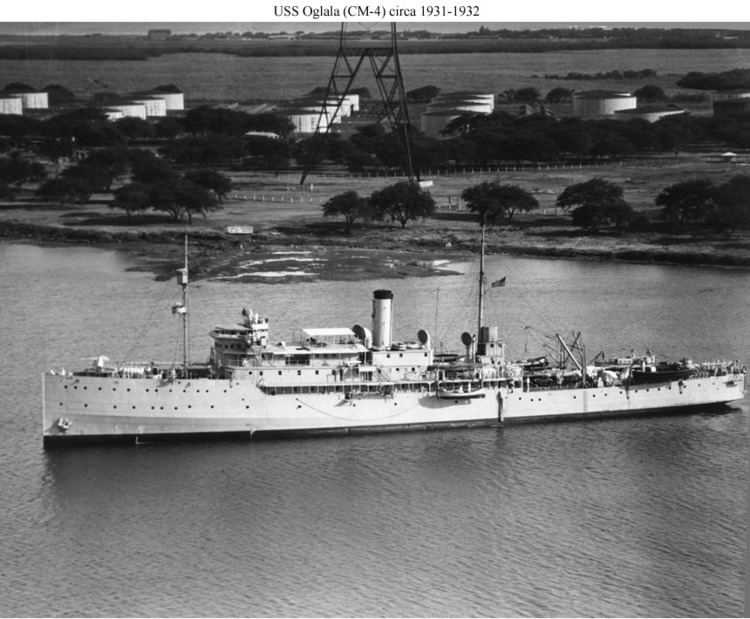
She was originally built as Eastern Steamship Company's SS Massachusetts by William Cramp and Sons of Philadelphia in 1907 for overnight coastal passenger steamer service through the Cape Cod Canal and Long Island Sound between Boston and New York City. After the United States entered World War I Massachusetts and her sister ship Bunker Hill were among the eight civilian steamships purchased to lay the North Sea Mine Barrage.
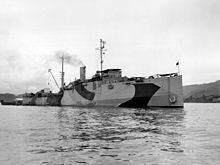
World War I
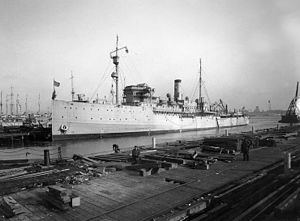
The Navy converted the two passenger steamships at the Boston Navy Yard with decks to improve seaworthiness as mine planters. The ship was commissioned as Massachusetts (ID-1255), on 7 December 1917, and renamed Shawmut on 7 January 1918. She steamed to Britain in June 1918 and spent the rest of World War I helping lay the anti-submarine mine barrage across the North Sea by:
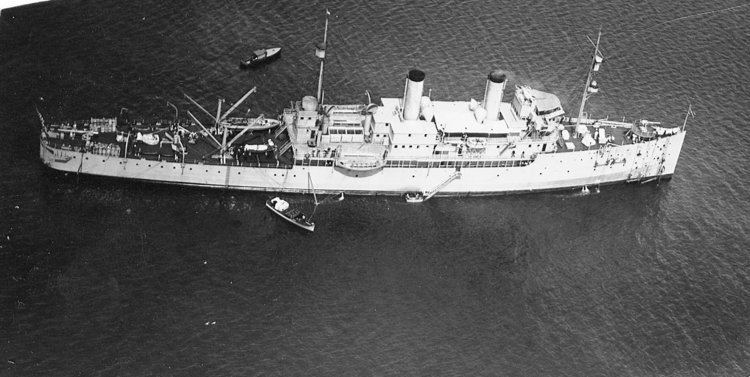

Shawmut laid a total of 2,970 anchored mines while under command of Captain Wat Tyler Cluverius, Jr., USN. Captain Cluverius had been a midshipman aboard Maine (ACR-1) at Havana Harbor. In December 1918, Shawmut returned to the United States.
Seaplane tender and minelayer

Through the next two decades, she served as an seaplane tender and minelayer, receiving the hull number CM-4 in 1920. To avoid verbal confusion with Chaumont (AP-5), she was renamed Oglala on 1 January 1928. At about the same time, she was given new boilers and other modifications, changing her appearance from two smokestacks to one. Oglala was flagship of the 1934 Aleutian Islands Survey Expedition.
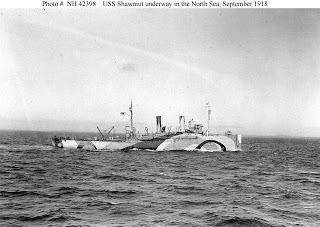
Despite many recognized deficiencies resulting from her civilian origins and advanced age, Oglala served as the Fleet's principal minelayer into the early 1940s under the command of Captain John L. Collis USN. Captain Collis was awarded the Legion of Merit as commander of a minelaying division in the Solomon Islands during World War II. When the Japanese attacked Pearl Harbor on 7 December 1941, she suffered underwater damage from nearby bomb and torpedo explosions, gradually rolled onto her port side and sank.
7 December 1941
On the morning of 7 December 1941 USS Oglala, flagship of the Pacific Fleet Mine Force, was tied up outboard of the light cruiser Helena (CL-50). They were alongside Pier 1010 at the Pearl Harbor Navy Yard, with an eight-foot floating cushion (camel) between them. Japanese torpedo planes of the first attack wave hit the cruiser with a single torpedo, which ran under Oglala to hit Helena's starboard side. The torpedo's explosion broke through the minelayer's port bilge amidships, and she rapidly took on water. A bomb that burst nearby caused further damage. The Oglala's hull had the marginal watertight integrity typical of older ships; as a result, the flooding could not be contained.
When it became clear that she might sink, Oglala was moved aft of Helena, so she would not pin the warship against the dock. About two hours after receiving her initial damage, she rolled over to port and sank beside 1010 dock. (At the time, wags in the Navy said that she had died of fright). There Oglala became the object of a prolonged, and ultimately successful, salvage effort.
Salvage, 1942
Though Oglala was originally evaluated as a total loss, with the only salvage goal being to clear valuable pier space, it was ultimately decided to fully recover and repair the ship. The salvage effort was complex work, with the inherent difficulties of righting and refloating a capsized ship compounded by Oglala's poor stability. Fifteen to eighteen divers were kept busy for nearly 2000 underwater hours during the salvage, patching her hull, rigging chains, cutting away unwanted structure and executing many other tasks. After her tophamper had been removed, ten salvage pontoons were used to pull the ship upright while air was pumped into her to lighten the load. The first parbuckling (or righting) attempt, made on 11 April 1942, failed when several connecting chains parted. However, a second try succeeded twelve days later.
Oglala was now upright, but still mostly underwater. A large wooden cofferdam was built around the edges of her decks to allow water to be removed from her interior. The ship was refloated in June, but resank on 25–26 June when the failure of a pump led to cascading flooding in her forward hull. Afloat again on 29 June, she promptly went down for a third time when the cofferdam failed. After another raising, a serious fire on 2 July nearly produced a fourth resubmergence. However, the next day Oglala was finally drydocked, completing a job that became a legend among marine salvors. She received temporary repairs during much of the rest of 1942 and, in December, left Pearl Harbor for the U.S. west coast, there to be refurbished for active service.
1943-1965
Through 1943 and into 1944, the old ship was permanently repaired and converted to an internal combustion engine repair ship. She was redesignated ARG-1 in May 1943 and recommissioned at the end of February 1944.
After arriving at Milne Bay, New Guinea, in April 1944, Oglala began tending patrol, mine and landing craft. She shifted her base to Hollandia, New Guinea, in July and to Leyte, Philippine Islands, in December 1944. Returning to the U.S. west coast in early 1946, Oglala was decommissioned in July of that year and transferred to Maritime Commission custody. She remained a depot ship at Benicia, California for the Suisun Bay National Defense Reserve Fleet until September 1965, when she was sold to Joffee Shipbreakers of Richmond, California for scrapping.
Decorations
The USS Oglala was entitled to display the Purple Heart, the World War I Victory Medal, the American Defense Medal, the American Campaign Medal, the Asiatic-Pacific Campaign Medal with two battle stars, the World War II Victory Medal, and the Philippines Liberation Medal.
